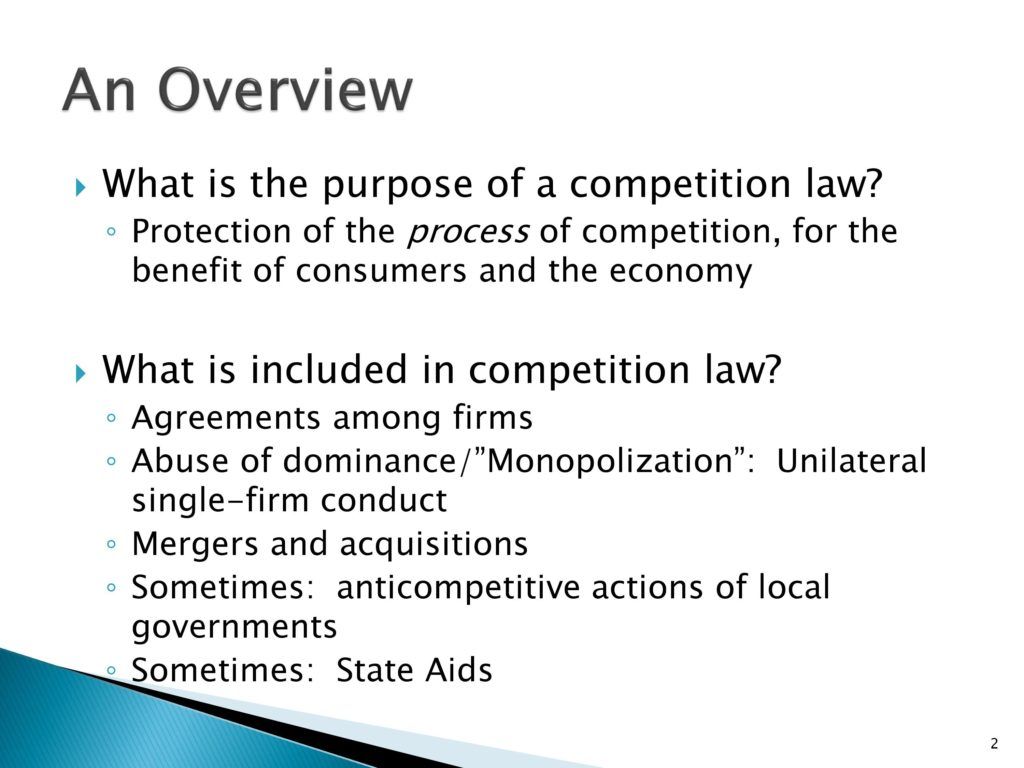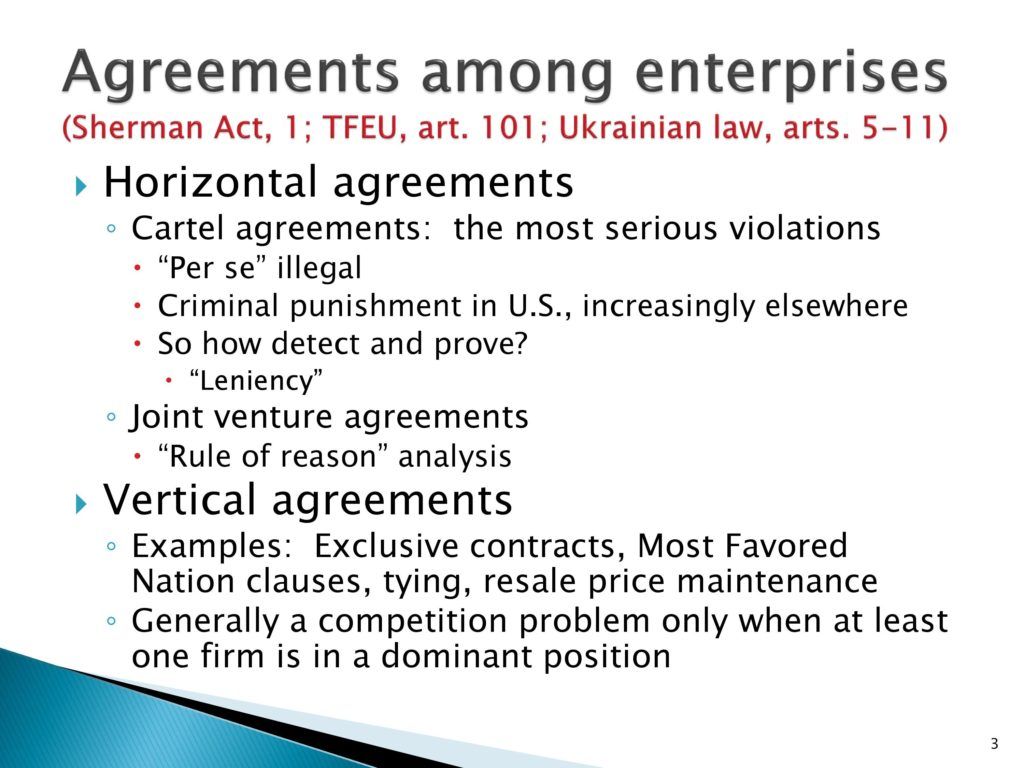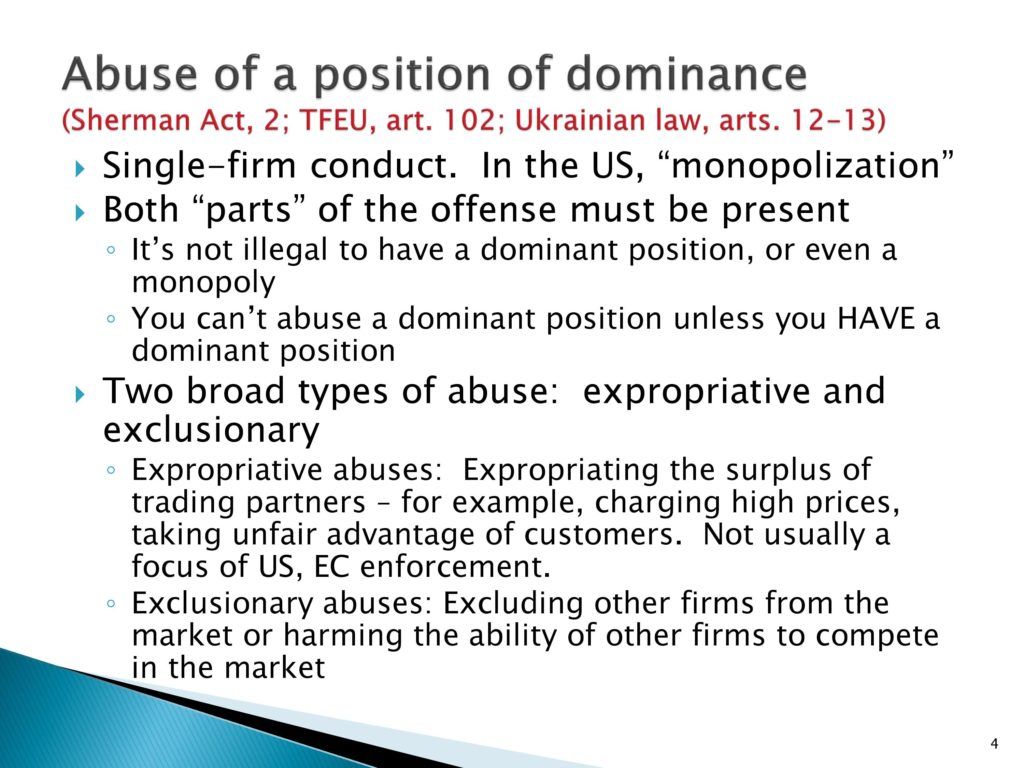Some competition laws, including the laws of Ukraine, Romania, Russia, and the European Union – but not those of the United States – include specific provisions against anticompetitive actions by government bodies, especially those of local governments that may favor local firms. And some, including those of the European Union but not those of the United States, include provisions targeting “state aids”. In Ukraine this latter issue is addressed by a separate law, not the competition law itself. I will focus in this paper on the competition laws that I know best, those of the United States, but will refer from time to time to those from other jurisdictions, including Ukraine.
Introduction
Market economies all over the world have competition laws. Many have been adopted in the past twenty-five years. Although each country’s law is different, there are notable similarities among them, both in overall purpose and philosophy and in detailed provisions.
Perhaps the most important feature shared by competition laws around the world is their overall purpose and theme: a focus on protecting the process of competition, for the benefit of both the population and the economy. Competition law drafters and enforcers tend to be believers in markets; they have accepted the evidence that for the most part, markets are the most efficient and effective way to allocate goods in an economy. They tend not to try to “second guess” market outcomes by directly controlling prices or profits. At the same time, they are constantly on the watch for actions by companies or by governments that seek to subvert markets, or to tilt their processes to favor certain actors over others.
Almost all competition laws are centered on three types of provisions:
- those related to agreements among firms
- those related to single-firm conduct by powerful firms,
- and those related to mergers and acquisitions among firms.

Some competition laws, including the laws of Ukraine, Romania, Russia, and the European Union – but not those of the United States – include specific provisions against anticompetitive actions by government bodies, especially those of local governments that may favor local firms. And some, including those of the European Union but not those of the United States, include provisions targeting “state aids”. In Ukraine this latter issue is addressed by a separate law, not the competition law itself.
I will focus in this paper on the competition laws that I know best, those of the United States, but will refer from time to time to those from other jurisdictions, including Ukraine.
The United States has the oldest formal antimonopoly policy in the world. It began with state-level “antitrust” laws in the 1860s and 1870s and culminated in the enactment first of the Sherman Act in 1890 and later in the Clayton Act and the Federal Trade Commission Act, both in 1914. The Sherman Act focused on two of the three principal areas of modern competition law enforcement: agreements among enterprises and the abuse of a dominant position by a single firm (or, as termed in the Sherman Act, “monopolization”). The omission from the Sherman Act of provisions addressing the third principal area of modern enforcement-combinations, or “mergers” among enterprises – has been blamed by some scholars for contributing to the great U.S. “merger wave” of the late 1890s [2], and this merger wave was one force behind the enactment of the Clayton Act, with its specific provisions addressing mergers. At the same time, a combination of Congressional dissatisfaction with the performance of the Department of Justice in enforcing the Sherman Act and the fear that the increasing complexity of antitrust enforcement in the modern business context required a specialized, expert antitrust agency led to the creation of the Federal Trade Commission, which shares responsibility for federal-level antitrust enforcement with the Justice Department [3].
These three areas of enforcement — agreements among enterprises, the abuse of a dominant position, and combinations among enterprises — are, as mentioned, the focus of most competition laws today. They provide a useful organizing structure for the examination of the antitrust laws in greater detail.
Agreements Among Enterprises
The Legal Standard
Section 1 of the Sherman Act states that “every contract, combination in the form of trust or otherwise, or conspiracy, in restraint of trade or commerce among the several States, or with foreign nations, is declared to be illegal.” The corresponding legal restrictions regarding agreements among enterprises are Article 101 of the Treaty of Lisbon (originally the Treaty of Rome, formally the Treaty on the Functioning of the European Union, TFEU) and Articles 5 through 11 of the Law of Ukraine on the Protection of Economic Competition.
Since virtually any business contract could be said to “restrain trade” in some way, the U.S. Supreme Court ruled long ago that this language was not to be interpreted literally. Rather, Section 1 has been interpreted by the Court as forbidding those agreements which restrain trade “unreasonably” – that is, “which [are] unreasonably restrictive of competitive conditions.” [4] This terminology might seem to suggest that the Supreme Court was calling for judges and juries to balance the competitive benefits and costs of each particular agreement, seeking to determine whether the agreement is “unreasonable”, and therefore illegal. And indeed in a variety of cases such a balancing — called a “rule of reason” analysis — must take place.
However, the Court in its enforcement has made a sharp distinction between horizontal agreements – that is, agreements among enterprises at the same “level” of the “production chain”, such as two manufacturers of the same product — and vertical agreements — agreements among enterprises at different levels of the production chain, such as between a manufacturer and its supplier or a manufacturer and its distributor. It has further directed that special treatment in enforcement be given to a particular class of horizontal agreements, sometimes called cartel agreements: those whose principal focus is the price that will be charged, the bid that will be submitted, the quantities that will be sold, or the customers or territories that will be served. The Supreme Court has determined that these kinds of agreements are so universally and obviously destructive of competition that they are always unreasonable and that they are thus illegal “per se”. [5] That is, if it can be proven that one of these types of agreements was actually entered into, the parties to the agreement are guilty of a Sherman Act violation, and no discussion of the alleged reasonableness or benefits of the agreement is necessary.
Exceptions?
A per se illegality rule for the most clearly anticompetitive of collective behavior has important advantages. It allows businesses to know with certainty that particular well-defined forms of behavior are illegal and will not be tolerated. (In fact, in the U.S. the prohibition of this behavior is considered so clear and certain that the behavior is ordinarily punished as a criminal, not civil, violation of the law.) It economizes on enforcement and judicial resources by not requiring an elaborate inquiry into the rationale or likely outcome of behavior that is almost always harmful to the public.
However, there have always been firms that have argued that their particular horizontal agreements had special public benefits and so deserved special treatment. It is worth addressing two of these defenses that have been decisively rejected by the Supreme Court along with one that has been accepted.
In 1927 the Sanitary Potters’ Association was found guilty of coordinating an agreement on price levels among its members — commonly termed “price fixing” — for sales of vitreous pottery for bathrooms and lavatories. The Association’s defense was that the prices fixed were “reasonable” and so did not harm the public. The Supreme Court found against the Association:
«The power to fix prices, whether reasonably exercised or not, involves power to control the market and to fix arbitrary and unreasonable prices. The reasonable price fixed today may through economic and business changes become the unreasonable price of tomorrow….Agreements which create such potential power may well be held to be in themselves unreasonable or unlawful restraints, without the necessity of minute inquiry whether a particular price is reasonable or unreasonable as fixed and without placing on the government in enforcing the Sherman Law the burden of ascertaining from day to day whether it has become unreasonable through the mere variation or economic conditions [6].»
So the “reasonableness” of the agreed upon prices was, and is, no defense against a price-fixing charge. A few years later, during the Depression, the major oil companies sought to stop the practice of some small firms of selling large quantities of crude oil and refined oil products at “distress” prices by agreeing to buy up the extra quantities themselves. When accused of violating the Sherman Act they argued that not only was the price level resulting from this collective arrangement “reasonable” but that in fact without this arrangement competition would be “cut-throat” and prices “ruinously” low. In other words, far from agreeing on monopoly prices, the parties to the agreement claimed that they were seeking to keep prices from falling so low that some of them would be forced out of business. The Supreme Court did not accept this argument, either:
«Ruinous competition, financial disaster, evils of price cutting and the like appear throughout our history as ostensible justifications for price fixing. If the so-called competitive abuses were to be appraised here, the reasonableness of prices would necessarily become an issue in every price fixing case. In that event the Sherman Act would soon be emasculated. …Congress has not left with us the determination of whether or not particular price-fixing schemes are wise or unwise, healthy or destructive [7].»
Thus not even the alleged “ruinous” or “destructive” nature of competition would be accepted by the Court as a defense to price-fixing under the Sherman Act.
The per se rule would preclude also any de minimis defense based upon the small size of the firms involved or their small share of the market in which they operate, and the Department of Justice has often prosecuted small firms operating in local markets. One could argue that firms whose shares of a market are collectively small could not effectively collude to raise price, and some competition laws do include an exemption from cartel provisions for firms with small market shares. Nevertheless the price of this provision would be a heavy one; if a firm must know the exact boundaries of the relevant markets in which it operates and both its own market share and the shares of its competitors in those markets to know whether it may legally engage in collusive agreements, the clarity and force of the per se rule are weakened considerably.
Still there are explicit agreements among competitors concerning price, output, and so on that do not ordinarily run afoul of the Sherman Act. These are agreements which are formed in the process of the creation of a joint venture or other legitimate joint activity and which are truly secondary or, in the language of the court decisions, “ancillary”, to that joint activity.
When two enterprises agree to engage in some joint, socially productive activity — for example, sharing a research and development project, or constructing a factory to manufacture a product that neither is currently producing – it may be necessary for them to agree not to compete in certain ways if they are to establish the cooperative relationship necessary for the joint productive activity to be successful. The courts have recognized this. Nevertheless, the courts have also taken care to insure that the joint activity is not a mere subterfuge to justify anticompetitive agreements.
Specifically, U.S. courts have been careful to insist that for a horizontal restraint to be considered “ancillary” — and so “reasonable” under section 1 of the Sherman Act — it must meet two conditions: it must be 1) closely related to the purpose of the joint activity and 2) no broader than necessary to achieve its purpose [8]. The usual judicial outcome of a negative finding in a rule-of-reason analysis would simply be a judicial order to amend or terminate the agreement.
Foreign Firms
Just as the acts of U.S. citizens in a foreign nation ordinarily are subject to the law of the country in which they occur, the acts of foreign citizens in the United States ordinarily are subject to U.S. law. Foreign firms that do business in the United States are fully subject to the antitrust laws, including the provisions of section 1 of the Sherman Act against “contract[s) …or conspirac[ies] in restraint of trade.” A foreign firm may be found guilty of participating in a conspiracy to fix prices, and its executives or agents may be subject to criminal penalties.
Indeed, even a foreign firm that does little or no business in the United States may be subject to the Sherman Act if it is party to an anticompetitive agreement that has a “direct, substantial, and reasonably foreseeable” effect on United States commerce [9]. Of course, whether the Department of Justice would actually seek to prosecute such conduct may be affected by a variety of factors, including both considerations of international relations and the issue of whether the foreign company may have been operating under either the “immunity” or the “compulsion” of the government of another country when acting in alleged violation of the laws of the United States [10].
Detection and Prosecution
As noted above, in the U.S. the prohibition of cartel agreements is considered so clear and certain, and the harm from such agreements so obvious, that this behavior is ordinarily punished as a criminal, not civil, violation of the law. In the period from 2005 through 2014, an average of 37 individuals were sentenced annually to be incarcerated, with an average sentence of 710 days – just shy of two years [11]. These numbers include foreign citizens convicted of participating in cartel agreements that harmed U.S. customers. This raises the question: how are these agreements – whose secrecy is carefully protected by their participants – uncovered and prosecuted?
Antitrust Division enforcers learn of the possible existence of illegal cartel agreements in a variety of ways. Customers may complain to the Division that they are receiving identical bids from multiple suppliers, or that only one potential supplier seems to be truly interested in obtaining their business.Employees of colluding firms – “whistle blowers” – may contact enforcement officials when they believe their employer is behaving unethically. Some industries in which local cartels have been discovered at particular locations may have cartels in other geographic markets as well.
In practice, however, the most powerful tool available to the Division in its cartel enforcement is its “leniency policy” [12]. This policy works as follows. The first member of a cartel – a participating company or an officer of a participating company – that contacts the Division to confess its illegal behavior and promise to cooperate with the Division’s investigation is not subject to criminal punishment for its part in the agreement. It is still subject to repaying customers for the cartel damages, usually through follow-on private lawsuits, but the company and officers are not subject to criminal fines, and the officers are not subject to incarceration.
There are some important details. Companies or individuals that were involved in organizing the agreement are not eligible – one cannot invite one’s competitors to form a cartel and then receive leniency when reporting to the authorities. Nor are any companies or individuals eligible for leniency who were involved in coercing others to join the illegal agreement. The leniency recipient must cooperate fully and honestly with the investigators, including testifying fully and truthfully at trial.
Only one cartel participant is eligible for leniency. The second or third company or individual to confess and volunteer to cooperate may succeed in negotiating reduced punishment in return for its cooperation – as with most criminal prosecution – but they are not eligible for full leniency.
The idea, of course, is to set up a “prisoners’ dilemma” for cartel members. Each member should fear that another member may succumb to the temptation to report itself to the Antitrust Division and thus escape criminal punishment if and when the agreement is detected and prosecuted. This is an especially powerful incentive when, as in the U.S., punishment includes potential imprisonment. Countries that have set up leniency policies but lack strong punishments for cartel participation have found less success.

Vertical Agreements
Although a large proportion of the enforcement activity under section 1 of the Sherman Act has been directed against horizontal agreements, the law applies to vertical agreements as well. Among the most important of vertical restrictions observed in market economies and covered by U.S. law are the following:
- tying: selling a product only on the condition that the purchaser will purchase a second product simultaneously;
- exclusive supply: purchasing a product only on the condition that the seller not supply one’s competitors;
- exclusive distribution: selling a product to a distributor only on the condition that the purchaser not also distribute the products of one’s competitors;
- territorial restrictions: selling a product to a distributor on the condition that the distributor sell only in a certain territory, often with the assurance that no other distributors of the product will be allowed to sell in that territory;
- refusal to deal: selling a product to some willing distributors but not to others, or refusal to sell a product to anyone (as opposed to, for example, leasing it);
- minimum resale price maintenance: selling a product to a distributor on the condition that the distributor will sell the product to its customers at an agreed-upon price, or at a price no lower than a certain price.
Historically, antitrust law had dealt somewhat harshly with vertical agreements and restraints – especially tying and resale price maintenance, which were treated as per se violations. However, over the past forty to fifty years, a growing body of economic and legal analysis has suggested that these kinds of restraints may perform useful and procompetitive functions in the economy — for example, to assure the maintenance of the quality of the product, to protect trade secrets, and to facilitate entry into new markets.
The law has thus come to treat most vertical agreements and restrictions under the rule of reason, in a relatively lenient manner: firms are free to choose their customers, their suppliers, and the terms under which they will deal with both their customers and suppliers, without interference from the antitrust laws, unless there is clear harm to competition. In turn, the most important prerequisite for a judicial finding of clear harm to competition from a vertical agreement has been a finding of a significant degree of market power (or, in the European phrase, “dominance”) held by one of the parties to the agreement.
In fact, in the presence of significant market power, vertical agreements and restrictions of the kind described above may be challenged as violations of section 2 of the Sherman Act rather than, or in addition to, as violations of section 1 — that is, as acts of “monopolization” or abuse of a dominant position [13].
Abuse of a Dominant Position, or “Monopolization”
As noted above, provisions in the US competition laws addressing abusive behavior by powerful single firms are included in Section 2 of the Sherman Act. The corresponding legislative provisions are Article 102 of the Treaty of Lisbon and Articles 12-13 of Ukrainian competition law. The most important aspect of the general competition law prohibition against abuse of a dominant position is that both terms of the phrase are crucial:
- The possession of a dominant position – even a monopolistic position – is not by itself a violation of any competition law of which I am aware. Indeed, a believer in markets should want firms to seek to achieve dominant or monopolistic positions by making and selling the best products possible. It is only the abuse of a dominant position that is a violation of the law.
- At the same time, a firm cannot abuse a dominant position if it does not have a dominant position – and this means both that market definition is a central part of any abuse investigation, and that behavior that may be perfectly legal – even pro-competitive – if engaged in by a firm with a small market share may be a violation if engaged in by a firm in a dominant position.
Competition law provisions addressing the “abuse of a dominant position” prohibit behavior that may be divided into two categories:
- “Exploitative” abuses: behavior that exploits the dominant position, for example by charging high prices, placing unreasonable conditions on purchasers, or earning high profits, without having a direct impact on the protection of the dominant position itself, and
- “Exclusionary” abuses: behavior that protects or “entrenches” the dominant position itself, by making it more difficult for competition to develop in the market.

- https://voxukraine.org//all-microeconomics-ua/
However, for the most part U.S. competition law enforcement under the Sherman Act is concerned only with the second category of behavior, that is, behavior that actually harms the process of competition. In general, an enterprise that has gained and held a dominant or even monopolistic position through legal means is free to attempt to charge whatever prices and earn whatever profits it can. Even in jurisdictions like the EU where exploitative abuses are clearly listed in the law, enforcers tend to focus more on exclusionary abuses as likely to cause greater and longer-lasting harm.
Similarly, most competition law provisions, including those of the United States, are careful to require a strong demonstration that an enterprise is in fact in a dominant or monopolistic position before the enterprise can be judged guilty of abusing that position. Typically this requires both the demonstration of a high market share – there is no single “bright line” in U.S. law, but 75 percent might be typical — and the presence of substantial barriers to new market entry. Competition laws in Europe tend to have lower concentration thresholds for a finding of dominance; as I read the Ukrainian law, Article 12 creates a rebuttable presumption of dominance for a market share of 35 percent.
Section 2 of the Sherman Act states that:
«Every person who shall monopolize, or attempt to monopolize, or combine or conspire with any other person or persons, to monopolize any part of the trade or commerce among the several States, or with foreign nations, shall be deemed guilty of a felony.»
This provision has always provided problems of interpretation which are founded upon the conflicting desires of society for, on the one hand, firms to compete as strenuously as possible and, on the other hand, for both consumers and other firms to be protected from the possible abuses of a firm that has competed so strenuously that it has achieved a monopoly position.
Early judicial interpretation of this provision was strict. The leading example is the “ALCOA” case [14], in which Judge Learned Hand, once he had established the possession of market power by ALCOA, condemned as monopolistic behavior (or “monopolization”) actions that would ordinarily be considered merely aggressive competitive conduct:
«It was not inevitable that [ALCOA] should always anticipate increases in the demand for ingot and be prepared to supply them. Nothing compelled it to keep doubling and redoubling its capacity before others entered the field. It insists that it never excluded competitors; but we can think of no more effective exclusion than progressively to embrace each new opportunity as it opened, and to face every newcomer with new capacity already geared into a great organization, having the advantage of experience, trade connections and the elite of personnel.»
Later courts feared, with good reason, that this interpretation of the Sherman Act would discourage business behavior that society would be better off encouraging, such as cost-cutting innovations and the construction of new productive capacity. The current judicial interpretation of the statutory language is thus significantly narrowed from that of Judge Hand:
«The offense of monopoly under section 2 of the Sherman Act has two elements: (1) the possession of monopoly power in the relevant market and (2) the willful acquisition or maintenance of that power as distinguished from growth or development as a consequence of a superior product, business acumen, or historic accident [15].»
The challenge remains, of course, to “distinguish” “growth or development as a consequence of a superior product” from “the willful acquisition or maintenance of [monopoly} power”. Public policy should not discourage businesses from seeking to provide such a good product that they will gain a high market share; in Judge Hand’s words, “the successful competitor, having been urged to compete, must not be turned upon when he wins.” [16] At the same time, public policy should not permit conduct that is clearly exclusionary, that preserves and protects a monopolistic position on the market.
One of the purest case examples of this exclusionary, anticompetitive behavior may be a Hungarian one. Following the privatization of the three Hungarian breweries, each brewery held something of a dominant position in its own geographic territory. One brewery, “Borsod Brewery”, at some point noticed that the brewery in the neighboring region, the Kõbánya Brewery, was having success in making sales in Borsod’s traditional territory. In response, Borsod began insisting that any wholesaler distributing Borsod beer limit its distribution of any other brand of beer to no more than ten percent of its total beer distribution. The distributors of the dominant regional brand, Borsod, could not afford to give up their business from Borsod, and many consequently cut back significantly on the volume of Kõbánya beer that they would distribute. The incursion of Kõbánya into Borsod’s territory was largely defeated, and Borsod had succeeded in “entrenching” its dominant position through exclusionary vertical agreements. The Hungarian Office of Economic Competition found Borsod guilty of an abuse of its dominant position, and ordered the contracts terminated [17].
Consider two United States examples. In the early 1950s there was formed in the United States a joint venture of flower sellers called the Florists’ Telegraph Delivery Association, or FTD. FTD was a nationwide network whereby
- A customer in, say, Washington, who wanted to send flowers to his mother in Atlanta could order and pay for the flowers in a flower shop in Washington;
- the flower shop in Washington would send along the order to the national FTD network, keeping a portion of the payment as a service fee;
- the national FTD network would send along the order to a flower shop in Atlanta, keeping a portion of the payment as a service fee; and
- the flower shop in Atlanta would receive the remainder of the payment and deliver the flowers to the mother of the original customer.
This network provided a valuable service to consumers, clearly increasing consumer welfare as a result.
However, at some point the FTD organization, fearing competition from the formation of other networks of flower shops, began insisting that flower shops belonging to the FTD network belong to no other such network. This contract provision had a substantially harmful effect on the incipient process of competition in the business of providing this nationwide network of flower shop coverage: the provision would make it very difficult for a new network to become organized, because it would not be in the interest of individual shops to leave the first organization until the second was fully structured and operational – and if it was not in the interest of any individual shop to join, then the second network would never become fully structured and operational.
The Justice Department sued FTD, which signed a consent decree agreeing no longer to impose this “exclusivity” requirement upon its members [18]. Later a second lawsuit was required to stop FTD from seeking to achieve the same outcome by providing monetary incentives to its members who did not belong to any other network.
A second example is the more recent litigation U.S. v. Dentsply International [19]. Dentsply enjoyed a 75-80 percent share (based on revenues) the U.S. market for artificial teeth (purchased by dental laboratories for the manufacture of dentures and other restorative dental appliances). The company sold mostly through independent distributors and had long had a policy of discouraging those distributors from carrying the artificial teeth of competing manufacturers; in 1993 it formalized this “exclusive dealing” requirement in its dealer contracts. Other modes of distribution were possible – including direct sales from manufacturers to laboratories – but the trial court found that the exclusive dealing requirement imposed significant disadvantages on the competitors of Dentsply, and the appeals court (overruling the trial court) found this to be a violation of the Section 2 of the Clayton Act. As Katz summarizes, the appellate decision “applied the standard that exclusionary behavior that significantly raises rivals’ costs can harm competition to the point of constituting a Section 2 violation without totally foreclosing competitors.”
Notes
[1] The views expressed do not purport to represent the views of the U.S. Department of Justice.
[2] See, especially, George Bittlingmayer, “Did Antitrust Policy Cause the Great Merger Wave?” Journal of Law and Economics 28 (1985), 77-118.
[3] Excellent discussions ot the historical development of U.S. antitrust enforcement are provided in Hans B. Thorelli. The Federal Antitrust Policy, London: Allen & Unwin, 1954, and David Kaserman and John Mayo, Government and Business: The Economics of Antitrust and Regulation, New York: Dryden, 1995.
[4] Standard Oil Co. v. United States, 221 U.S. 1, 58 (1911).
[5] See Northern Pacific Railway v. United States, 356 U.S. 1, 5 (1958): “There are certain agreements or practices which because of their pernicious effect on competition and lack of any redeeming virtue are conclusively presumed to be unreasonable and therefore illegal without elaborate inquiry as to the precise harm they have caused or the business excuse for their use.” See also National Society of Professional Engineers v. United States, 435 U.S. 679, 692 (1978).
[6] United States v. Trenton Potteries Company, 273 U.S. 392, 397-98 (1927).
[7] United States v. Socony-Vacuum Oil Company, 310 U.S. 150, 221 (1940).
[8] American Bar Association, Antitrust Law Developments (Seventh), Chicago: American Bar Association, 2012, at v. 1, p. 479, citing Brunswick Corp,, 94 F.T.C. 1174, 1275 (1979).
[9] Foreign Trade Antitrust Improvements Act of 1982, Public Law No, 97-290, 96 Stat. 1246 (1982). codified at 15 U.S.C. 6a (1988).
[10] See U.S. Department of Justice and Federal Trade Commission, Antitrust Enforcement Guidelines for International Operations, Washington, DC: April 1995, at 23-26.
[11] Antitrust Division Workload Statistics, FY2005-2014, U.S. Department of Justice, https://www.justice.gov/atr/file/788426/download.
[12] For details, see, e.g., Scott Hammond and Belinda Barnett, “Frequently Asked Questions Regarding the Antitrust Division’s Leniency Program and Model Leniency Letters (November 19, 2008),” https://www.justice.gov/atr/file/810001/download.
[13] For more extensive discussions of vertical restraints, see Francine LaFontaine and Margaret Slade, “Exclusive Contracts and Vertical Restraints: Empirical Evidence and Public Policy,” in Paulo Buccirossi, ed., Handbook of Antitrust Economics (MIT Press, 2008), or Stephen Martin, Industrial Organization in Context (Oxford University Press, 2010), ch. 24.
[14] United States v.Aluminum Company of America. 148 F.2d 416 (2d Cir. 1945).
[15] United States v. Grinnell Corporation, 384 U.S. 563, 570-71 (1966), emphasis added.
[16] ALCOA, 148 F.2d at 430.
[17] Borsod Brewery Pie., Hungarian Office of Economic Competition Council Decision Vj-52/1992.13, June 9, 1992.
[18] U.S. v. Florists’ Telegraph Delivery Association, Civ. No. 15748 (E.D. Mich.), Complaint (June 1, 1956) and Final Judgment (June 1, 1956).
[19] 399 F.3d 181 (3d Cir. 2005), overturning 277 F. Supp. 2d 387 (D.Del. 2003). For a clear and thorough discussion of the case, see Michael Katz, “Exclusive Dealing and Antitrust Exclusion: U.S. V. Detsply,” in John Kwoka and Lawrence J. White, eds., The Antitrust Revolution: Economics, Competition, and Policy (6th) (Oxford University Press, 2014).
Attention
The author doesn`t work for, consult to, own shares in or receive funding from any company or organization that would benefit from this article, and have no relevant affiliations



